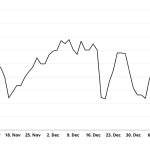
When investing in stocks to triple your returns, you’ll have to ratchet up the risk. There’s just no way around it.
Before we consider stocks to buy to triple your returns in 2024, let’s consider how many stocks have returned 200% in 2023 through Oct. 30. According to Finviz.com, there are zero S&P 500 stocks up more than 200% in 2023. There are just two up more than 100%: Meta Platforms (Nasdaq:META) and Nvidia (NASDAQ:NVDA).
Of course, the S&P 500 is up just 8.9% year-to-date. In 2021, the index gained nearly 27% on the year. The best-performing S&P 500 stock in 2021 was 198%. This tells us that we must broaden our search beyond the index, perhaps focusing on smaller stocks more prone to significant gains.
The Russell 2000 are 2,000 smaller companies included in the Russell 3000, which accounts for 98% of U.S. publicly traded stocks. The Russell 2000 is down more than 5% YTD.
According to Finviz.com, 47 stocks in the Russell 2000 are up 100% or more in 2023. While it won’t guarantee success, it is from this group I’ve chosen to look for my three stocks to triple your returns in 2024.
IonQ (IONQ)

However, my first pick is IonQ (NYSE:IONQ), a Maryland-based quantum computing company. Its shares are up 181% year-to-date, although they touched $20 as recently as September, so you can be sure IONQ’s volatility is high, a must for delivering 200% returns.
The company’s mission is “To build the world’s best quantum computers to solve the world’s most complex problems,” states the company website. It was founded in 2015 with $2 million in seed funding and a desire to build high-performance quantum computers.
On Sept. 30, 2021, the pure-play quantum computing company went public by merging with dMT Technology Group, a special purpose acquisition company (SPAC). The combined entity had an enterprise value of $1.4 billion, providing $300 million in cash from the SPAC and another $350 million from a private investment in public equity (PIPE). It planned to use the proceeds to bring its trapped-ion quantum computing technology to the masses.
In August, the company announced Q2 2023 results that included $5.5 million in revenue and second-quarter bookings of $28 million. For the full year, it expects revenue of at least $18.9 million, with full-year bookings of between $49 million and $56 million.
Not surprisingly, IonQ is losing money. In the first six months of 2023, its operating loss was $61.1 million on $9.8 million in revenue.
PetIQ (PETQ)

I’m an animal lover, so I couldn’t resist selecting PetIQ (NASDAQ:PETQ) despite the fact it’s only gained 94% YTD, according to Google Finance. However, Finviz data puts it above 100%, so I’m running with it.
PetIQ was founded in 2010 and went public in July 2017, selling 6.25 million shares at $16.
“PetIQ is a rapidly growing distributor and manufacturer of veterinarian-grade pet prescription (“Rx”) medications, over-the-counter (“OTC”) flea and tick preventatives and health and wellness products for dogs and cats,” stated pg. 1 of its 2017 prospectus.
“We pioneered and are the leading seller to the retail channel of pet products that were previously available for purchase primarily from veterinary clinics.”
What makes PetIQ different is that, in addition to supplying prescription and OTC medications and other health and wellness pet products, it also provides veterinarian services at 2,600 locations in 41 U.S. states through its retail partners who also sell its products.
It expects to open an additional 1,000 wellness centers in underserved markets across the U.S. within Tractor Supply (NASDAQ:TSCO) and Walmart (NYSE:WMT) locations.
In the most recent quarter, the company grew its sales by nearly 25% to a record $314.5 million, well above its guidance. Its adjusted net income was $13.4 million, 36.4% higher than a year earlier.
Based on its sales guidance for 2023 of $1.03 billion at the midpoint, it is trading at 0.53x its sales.
Powell Industries (POWL)

Powell Industries (NASDAQ:POWL) is up more than 118% in 2023 and more than 203% over the past 52 weeks.
If you’re like me, you probably have never heard about Powell Industries. Founded in 1947 in Houston, it originally provided metal working services for the petrochemical industry.
Today, it manufactures and services custom-engineered equipment and systems for many different industries. Its products include integrated power control room substations (PCRs), custom-engineered modules, electrical houses (E-Houses), traditional and arc-resistant distribution switchgear and control gear, and more.
I’m not the handiest guy, so many of the abovementioned products and their usefulness are beyond my pay grade.
What I do understand are the company’s financial statements.
In Q3 2023, Powell’s revenues increased 42% to $192.4 million, while its operating income was $21.6 million, considerably higher than $849,000 a year earlier. Its gross margin in the quarter was 22.2%, 810 basis points higher than a year earlier.
Two numbers that jump out at you are its backlog and new orders at the end of the third quarter. The former was $1.3 billion, 31% higher than Q1 2023 and an increase of 166% from Q3 2022. In addition, it had $505 million in new orders placed in the third quarter, flat to Q2 2023 but 150% higher than a year earlier.
The company did admit that large liquid natural gas (LNG) and petrochemical projects were the cause for such growth in the first nine months of 2023. It anticipates business will slow some heading into 2024.
Overall, however, it expects to be busy in 2024.
While it might differ from the type of company you expect to grow rapidly, the ongoing infrastructure spending in the U.S. should continue to help drive its business in the future.
Consider this my wildcard play.
On the date of publication, Will Ashworth did not have (either directly or indirectly) any positions in the securities mentioned in this article. The opinions expressed in this article are those of the writer, subject to the InvestorPlace.com Publishing Guidelines.




